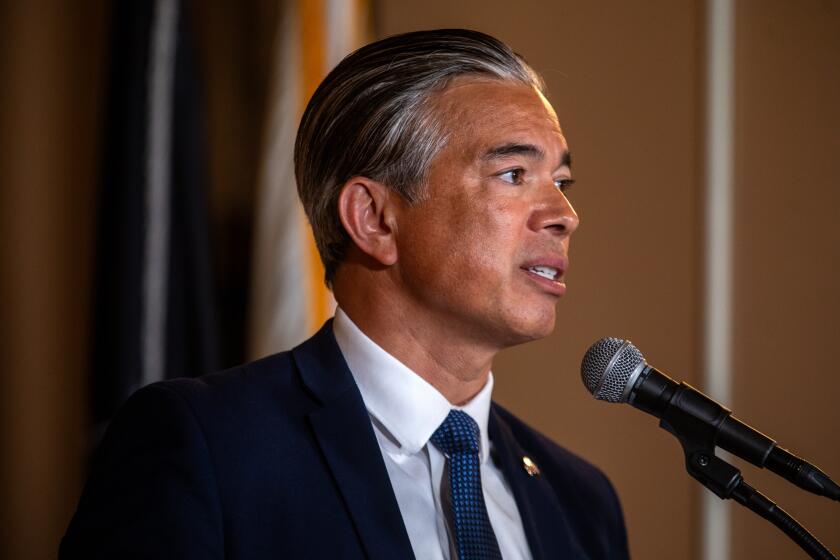Utility Rate Cut Leaves Many in the Dark
Frany Lee Carr heard the good news on the radio--her monthly electric bill was going to be cut by 10%. Then she looked at her statement.
“I said, ‘Whoa, wait a minute, that’s not 10%,’ ” said Carr, perplexed by what looked suspiciously like a new charge a few lines below the rate cut. “Is it a trick? Or is it that I just don’t understand this darn thing?”
For the record:
12:00 a.m. April 29, 1998 For the Record
Los Angeles Times Wednesday April 29, 1998 Orange County Edition Part A Page 3 Metro Desk 1 inches; 23 words Type of Material: Correction
Electricity--A story Tuesday about electricity rates misstated the amount raised by bond sales to finance a 10% rate reduction. The bonds raised $6.5 billion.
The Huntington Beach mother and store clerk isn’t the only one befuddled.
Since the discount began in January, more than 2,000 ratepayers have called a 24-hour hotline set up by the state Public Utilities Commission to complain about the complex billing statements.
“It just looks like a lot of mumbo jumbo, and it’s just like picking a long-distance company,” Santa Ana resident Mimi Queseda said. “Most people would rather not deal with it.”
The new statements, crammed with an array of specific charges and explanations designed to enlighten customers, have instead left many in the dark. At issue is a line in people’s electricity bills that indicates that consumers are being charged for the cost of financing the rate cut.
Even PUC spokeswoman Kyle Devine conceded that she doesn’t understand the rate reduction plan or its explanation in the bills. Electricity bills are “so confusing I could just scream,” Devine said.
The commission, which mandated the language on the bills, now is trying to make the statements clearer, Devine said.
In the meantime, industry experts interviewed in recent days explained it this way:
For the next four years, customers are getting a 10% rate cut, under a provision of the law that opened California’s electricity market to competition. To finance that discount, the utilities raised $6.5 million by selling bonds. Eventually, customers will have to pay back those bonds.
The bottom line: While customers are saving 10% now, the payments on the bonds will reduce the savings generated by the rate cut over the next decade to less than 3%.
The big three publicly owned utilities--Southern California Edison Co., San Diego Gas & Electric Co. and Pacific Gas & Electric Co.--acknowledge that the 10% rate cut is not 10% over time. But they defend the rate cut as a way to give residents and small businesses a break now.
“There’s no smoke and mirrors. Your bill today is 10% less. Your bill will be 10% less and the check you write will be 10% less,” said John Fielder, an Edison senior vice president.
Consumer advocates Ralph Nader and Harvey Rosenfield have used the rate cut as a call to arms to unplug the whole deregulation deal.
Together with five consumer groups from San Francisco to San Diego, they have pushed to get an initiative on the November ballot to dismantle the new law, which they call a “big fraud.”
Initiative proponents have spent more than $500,000 in less than two months to gather half the 433,000 signatures needed to qualify the measure for the ballot. They are approaching people at malls and on streets from one end of the state to the other over the next six weeks to pick up the rest. The billing boondoggle has made for some easy converts.
“When I saw it there all laid out for me on my utility bill, I just couldn’t believe it,” San Diego resident Brad Drake said. “Why are we being asked to pay for our own rate cut?
“I feel like Sacramento didn’t do its job,” he said. “I feel like they just gave everything away to the utilities, like they just gave away the store.”
Robert Kinosian, a senior analyst with the utility commission’s Office of Ratepayer Advocates, said, “People look at their bills and they say, ‘What is this? Do we have to pay more?’ It is very confusing. And then they go out and sign one of these petitions.”
Among other things, the initiative would do away with the 10% rate cut and obligate the utilities to pay off the bonds sold to finance the reduction. In its place, the initiative proposes a 20% cut in utility rates, to be paid for out of power company revenues.
“I consider myself an expert in industries that try to dazzle people with numbers, but when you come down to it, this is just a big fraud,” consumer crusader Rosenfield said.
The California Chamber of Commerce calls the initiative a simplistic response to some of the hard decisions lawmakers spent three years making to open up the state’s electricity market.
Deregulation may not be perfect, they say, but it is already saving businesses that are big electricity users millions of dollars.
If the initiative passes, the state would face lawsuits from investors who bought the rate-cut bonds, said Allan Zaremberg, the chamber’s president.
“If these ads or these bills are misleading consumers, is that a reason to turn everything upside-down? If there was a better way to do that, that doesn’t mean you throw the entire deregulation and competition out to do that,” he said. “That doesn’t mean you should eliminate competition for electric rates in California.”
State Sen. Steve Peace (D-Cajon), who co-authored the deregulation legislation, calls the initiative “fairy dust” that would never hold up in court.
The 10% discount, he said, was “a conscious effort” by the Legislature to force prices down for residents and small businesses because they can’t take advantage of deregulation. The competition ushered in by the new law is cost-effective only at the major-company level.
“We did the best we could for the small ratepayers,” Peace said. “We saved them money.”
Maybe, but that appears to be a hard sell, said Kinosian from the PUC. “Everybody seems to have a lack of faith in their electric company,” he said.
For most customers, switching to another power company isn’t in the cards. Since April 1, they have been able, in theory, to choose their power supplier, but the new companies don’t find it worthwhile to install electrical lines for any but the major commercial and industrial users.
Customers of municipally owned utilities such as the Los Angeles Department of Water & Power or the Anaheim Public Utilities Department don’t have to worry about the problems wrought by deregulation. Because those utilities are not regulated by the PUC, they are exempt from that law. Their customers don’t get a 10% cut, but they also aren’t paying off the bonds.
Those utilities, competing fiercely with the big power companies for customers in their own cities, are wasting no time capitalizing on the confusion as they court new customers.
The Riverside utility, for instance, warned its 92,000 customers in bills last month: “Don’t be fooled by Edison’s 10% reduction.” The municipal utilities of Anaheim and Los Angeles are repeating a similar mantra.
(BEGIN TEXT OF INFOBOX / INFOGRAPHIC)
Filling the Bill
Since January, California electricity users have been reading new bills. Specific charges are listed to explain what those payments cover. The result: lots of confusion. Here’s what you pay and why you pay it:
California customers will get a 10% rate cut for the next four years, but during the next 10 years, payments on bonds purchased to finance the reduction will reduce the savings to about 3%, according to the Public Utilities Commission.
Sources: California Public Utilities Commission, Southern California Edison
More to Read
Start your day right
Sign up for Essential California for news, features and recommendations from the L.A. Times and beyond in your inbox six days a week.
You may occasionally receive promotional content from the Los Angeles Times.






